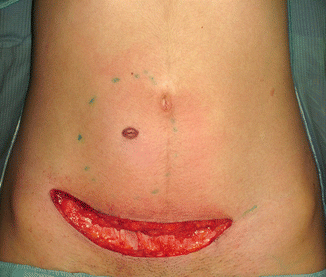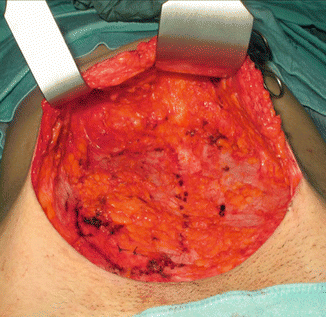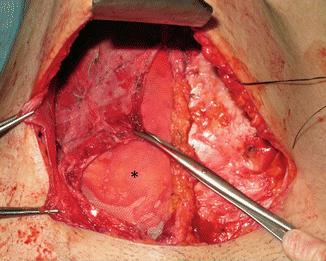Fig. 24.1
Planning of the incision line is done preoperatively with the patient in a standing position. Postoperatively the incision line (black curved dotted line) can be easily hidden by the patient’s underwear. The palpable tumor mass margins are marked (green dotted circle)

Fig. 24.2
A horizontal skin incision is performed. In case of a prior cesarean section, the scar is used as incision line. The palpable tumor mass (green dotted circle) and the biopsy punch channel (blue circle) were marked preoperatively

Fig. 24.3
Cephalad mobilization of the abdominal flap toward the xiphoid process centrally and the costal margins laterally ameliorates the access to the tumor mass. The radical resection margins are marked (blue dotted circle)

Fig. 24.4
After muscle relaxation, component separation of the abdominal wall muscles is performed, which aids to narrow the resection margins and to reconstruct the abdominal wall. A nonabsorbable polypropylene surgical mesh can be placed to facilitate the defect closure (asterisk)
24.3 Discussion
Desmoid tumors of the abdominal wall are mostly found in fertile woman aged between 25 and 45 years [5]. Wide surgical resection with histologically clear margins is still regarded as the therapy of choice [3, 5]; however, reports with adjuvant radiation therapy claim minor recurrence rates [11]. Often, these wide resections are performed through a direct approach [3, 7] and leave unpleasant scars in these young and often aesthetically demanding patients. A reverse abdominoplasty has been described before for aesthetically pleasing results for defect coverage after wide resection of abdominal dermatofibrosarcoma protuberans [12]. Similarly the author’s abdominoplasty approach for resection of desmoid tumors in this location allows for a naturally appearing abdomen with very little to no donor site morbidity and almost invisible scaring, which can easily be hidden by the patient’s underwear (Fig. 24.5). Depending on the size of the tumor, component separation of the adjacent abdominal muscles alone is often not sufficient for defect coverage after wide resection, making the use of absorbable or nonabsorbable meshes necessary [5]. Through the abdominoplasty access [8], an extensive, well-perfused abdominal flap is dissected, which helps to gain overview on the one hand and on the other hand, through the extensive tissue coverage of the resection zone, in combination with the distant skin incision line, may prevent complications and wound healing disturbances, even if an adjuvant radiation therapy is performed postoperatively. In case of preexisting abdominal scars, due to prior surgical interventions, the abdominal flap survival can be secured by performing a perforator-sparing abdominoplasty as described by Rieger et al. [10]. The cosmetic result achieved with this surgical technique is excellent (Fig. 24.5




Stay updated, free articles. Join our Telegram channel

Full access? Get Clinical Tree







